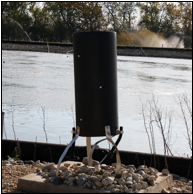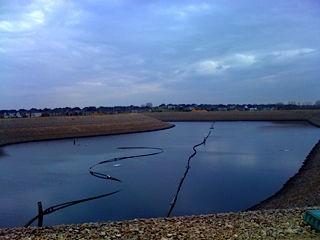Lagoon Coarse Bubble Aeration is the second most common type of diffused wastewater lagoon aeration, behind fine bubble. The bubbles released are much larger than fine bubbles, usually around 6–13mm (fine bubbles usually fall around 1–2mm). These bubbles are very buoyant, and as a result they rise quickly and turbulently to the surface.
Coarse bubble lagoon diffuser aeration systems are composed of dozens to hundreds of coarse bubble lagoon diffusers, depending on the size of the facility. While this method of wastewater treatment can be effective, it is widely accepted that coarse bubble lagoon aeration is less efficient than fine bubble lagoon aeration. With us living in the “Go Green” era, this is causing coarse lagoon bubble aeration to lose significant market share to other lagoon aeration technologies.
This article intends to give a full, unbiased breakdown of wastewater lagoon coarse bubble aeration in wastewater lagoons. Please don’t hesitate to contact us with questions or comments.
4 Main Types of Coarse Bubble Diffusers
- Cap Disk Diffuser: This is simply a molded horizontal disk with a vertical threaded fitting. Air is released through static orifices, which forms the large bubbles. A variation on this releases the air from orifices on the underside of the disk.
- Duckbill Diffuser: This is a molded rubber sleeve with a variable orifice on one end and a threaded fitting on the other. The orifice is sealed by the pressure of the surrounding water. However, as air flows through the diffuser, this backpressure is overcome and large bubbles are released.
- Drilled Tube Diffuser: This is simply a pipe that has holes drilled in it. Air flows

Wastewater Lagoon Coarse Bubble Static Tube Aerator through the pipe, and out the drilled holes to create the bubbles.
- Static Tube Diffuser: This is a hollow tube with air piping at the bottom, through which air is released. As coarse bubbles rise through the tube, a draft-tube effect occurs. Water is then pulled from underneath the tube, and any debris is sucked up, mixed with the bubbles and broken down. Coarse Bubble Static Tube diffusers are the most common type of coarse bubble diffuser found in aerated lagoons.
Benefits of Lagoon Coarse Bubble Aeration (Pros)
In terms of wastewater aeration performance, the biggest win for lagoon coarse bubble aeration is its mixing performance. There are other benefits, but at the end of the day, your aeration performance is what matters most. Below is a breakdown of the main benefits from lagoon coarse bubble aeration systems:
- Water Mixing: Due to the size of the coarse bubble, more wastewater is displaced when the bubbles are released from the diffuser. As a result, turbulence occurs in the water that would be much less pronounced with smaller bubbles (i.e. fine bubbles). For more on the importance of mixing, read our blog: Wastewater Lagoon Mixing Alleviates Odor & Sludge Issues.
- Durability: Due to the fact that there are no moving parts on a lagoon coarse bubble diffuser, it tends to cause very few maintenance problems. Similarly, the designs are generally robust. It’s not uncommon for coarse bubble systems to last 20 years or more without any maintenance (provided the header piping holds up).
- Alpha Value: Lagoon coarse bubble diffusers have a high alpha value, meaning that they are not negatively affected by surfactants. These surfactants inhibit the transfer of oxygen to the water. Since coarse bubbles rise so quickly, surfactants often don’t have time to create this barrier.
- Few Motors to Maintain: Lagoon coarse bubble systems require just one blower onshore to provide air to an entire system. This makes maintenance a much simpler task.
Disadvantages of Lagoon Coarse Bubble Aeration (Cons)
Unfortunately for wastewater lagoon coarse bubble aeration, it is simply becoming an outdated technology as the industry continues to progress. While coarse bubbles can mix water well, they cannot transfer air as well as aeration alternatives. Below you’ll find a few main disadvantages of the wastewater lagoon coarse bubble aeration system:
- Inefficient Aeration: Due to the size of the coarse bubble, there is limited surface area for the oxygen to actually come in contact with the water (especially compared to fine bubbles). As a result, the efficiency with which oxygen is transferred to the water is far below that of fine bubble aeration. In order to try and transfer a comparable amount of oxygen, you must pump more air. And when you pump more air, your efficiency continues to drop. You simply can’t win in terms of oxygen transfer when comparing wastewater lagoon coarse bubble aeration with fine bubble.
- Difficult to Install and Access: Most lagoon coarse bubble systems are anchored to the bottom of the wastewater lagoon. Therefore, any installation, maintenance, or

Wastewater Lagoon Coarse Bubble Diffusers are anchored to the bottom, which makes the system difficult to access for maintenance without draining the lagoon. retrofitting will result in the draining of the basin, as well as necessary sludge removal. This can become a laborious and costly process.
- Potential to Clog: If a coarse bubble diffuser isn’t outfitted with backflow sealing, it’s very easy for debris to clog the orifice when the air is switched off. This can cause backpressure issues, energy efficiency problems, and a maintenance hassle.
- Only Effective in Deep Applications: Since the lagoon coarse bubble system is so poor in terms of transferring oxygen, the only way to accommodate this is by installing it as deep as possible in the wastewater lagoon. The deeper these bubbles are released, the more time they spend in the water, and likewise the more oxygen they transfer. However, many times there are limits on depth, and more water means more of a hassle when it comes to draining the lagoon for any maintenance issues.
There are a few applications here or there where lagoon coarse bubble systems are still a good fit. However, due to its inefficiency, difficult installation, and potential for clogging, it has become increasingly tough for wastewater lagoon coarse bubble aeration to compete. It would seem that its best days are behind it, and the future of diffused aeration lies with fine bubble technology.
